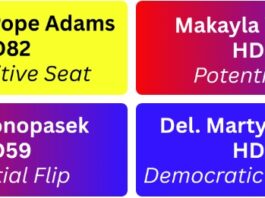Last year after tracking bills throughout the General Assembly session, VAPLAN had this *great* idea to make a scorecard, summarizing how progressive–or not–the legislators were, based on the bills that we’d been following. Apparently, although special interest groups often create scorecards for particular issues like the environment or business, there wasn’t really one that crossed over multiple legislative areas to measure overall progressiveness.
Despite our scorecard being used repeatedly by the Comstock campaign in a pathetic attempt to criticize the perfect-scoring Jennifer Wexton, we decided to bring it back again this year! So, without further ado, here’s the 2019 VAPLAN legislative scorecard!
Full results and data can be found HERE.
Top Scores:
This year there were no perfect scores in the House (due to a unanimous block vote on a non-progressive bill to set a mandatory minimum life sentence on capital murders), but Adam Ebbin (D-30), Dave Marsden (D-37), and Scott Surovell (D-36) had perfect scores in the Senate. In general, the Senate Democrats voted more as a bloc this year, and more progressively; perhaps because this is an election year for them, or maybe the effect of having a new Caucus Whip (Surovell).
In the House, the top scores were Marcus Simon (D-53), Sam Rasoul (D-11), and Kaye Kory (D-38) (who was a co-sponsor on a high number of the bills we tracked). Last year’s most progressive Delegate, Alfonso Lopez (D-49) came in a still-high 5th this year.
Bottom Scores:
The least progressive Senators were Obenshain (R-26), Carrico (R-40), and Newman (R-23); the least progressive Delegates Gilbert (R-15), Poindexter (R-09), and McNamara (R-08). Senate Republicans were less conservative than House Republicans–the bottom three in the House each only cast the progressive vote on one bill out of all those they voted on, where the low scorers in the Senate still voted more than 5 times with the progressive opinion.
Centrists:
The Delegates voting closest to the center are Democrats James and Heretick, and Republicans Thomas and Yancey, both of whom were elected by slim majorities–one who had to have his name drawn from a bowl to be declared winner. In the Senate, the centrists were Petersen (D-34), Dunnavant (R-12), Hanger (R-24), and Vogel (R-27).
Notes:
The scorecard is calculated from the votes on 56 bills that came up this year, on topics from the environment, campaign finance reform, criminal justice, gun violence prevention, LGBTQ discrimination, and more. For every progressive vote a legislator cast on a bill (either in subcommittee, committee, or on the floor, depending on where the last vote was taken), they scored one point; for every non-progressive vote, -1. Additionally, we assigned plus or minus points for signalling intent to vote by co-sponsoring a bill. Any bill that the legislator had no vote on (either from abstaining, absence without recording intended vote, or from not being on the committee where the bill was voted on) is scored a zero.
The legislator’s total score is the sum of all the bill scores, divided by the number of bills that he or she could have cast a vote on, so that the final score measures the percent of votes cast on these bills that were progressive. The measure ranges from 1 (all votes cast were progressive) to -1 (no progressive votes were cast).
We received some feedback last year against including subcommittee and committee votes on bills. While it is true that these votes do not necessarily indicate how a legislator might have voted had the bill made it to the floor for a vote (and subject to whatever amending or substituting it might have undergone by then), we felt that restricting our attention to bills that made it to floor votes would artificially skew the data towards bills that were either nearly unanimous, or were a pure party-line split. The bulk of bills do not make it to floor votes, so throwing away the information committee votes contain limits our analysis too much. Additionally, last year we re-calculated the scorecard excluding them and did not find any large changes in the overall rank of legislators. Similar criticisms are possible for assigning points for co-sponsoring bills (and in fact, we saw a few rare instances where the co-sponsor voted against the bill), but we want to take advantage of every bit of information the process contains.
For more information on the methodology of the VAPLAN scorecard and some caveats, see here.



